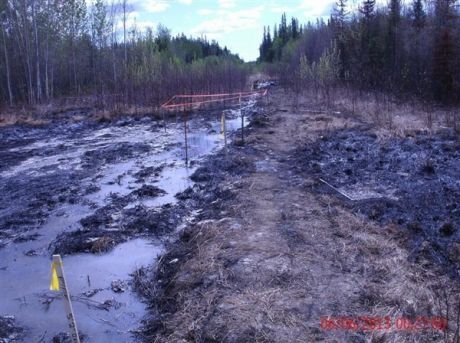News
You are here
Tar Sands flooding: an unreported environmental disaster

July 1, 2013
Virtually unreported among the Alberta flood stories is news that unprecedented flooding in the Tar Sands region of Fort McMurray threatens to unleash further environmental disaster.
The Tar Sands are a local environmental disaster. Cree and Dene inhabitants of Fort Chipewyan, downstream from the Tar Sands, have for years reported deformed and cancerous fish in the Athabaska river. They also suffer from extremely high rates of rare cancers, a claim denied by the oil industry and the Alberta government.
The Tar Sands are also a global environmental disaster, increasing global warming and the resulting extreme weather events. Now the epic floods in Alberta are compounding the environmental disaster of the Tar Sands. The town of Fort McMurray declared a state of emergency, with roads washed out and bridges closed. Between 100 and 180mm of rain hit the region.
Just days before the flooding occurred, an international scientific panel from the Rosenburg International Forum on Water Policy warned that the toxic “tailing ponds”—waste water lakes large enough to be visible from space—are a threat not just to the Athabaska River, but the entire Mackenzie River Basin. According to industry reports the ponds hold billions of litres of poisoned water from bitumen production. They cover 176 square kilometres in the Fort McMurray area. Some of the ponds are within 500 metres of the Athabaska River.
Toxic Tories
Oil industry and government sources have been quick to reassure investors that Tar Sands mining is “unaffected.” Apart from ordering a boil-water advisory for Fort McMurray and downstream communities, they are less forthcoming about the state of the local environment.
Even before the flooding it was proved that, contrary to industry and government propaganda, the toxic ponds were leaking into groundwater and into the river system. But it took a Freedom of Information action to reveal the documents. A memo to Natural Resources Minister Joe Oliver states: “The studies have, for the first time, detected potentially harmful, mining-related organic acid contaminants in groundwater outside a long-established out-of-pit tailings pond. This finding is consistent with publicly available technical reports of seepage (both projected in theory, and detected in practice).”
Recall that it was Oliver, defending the Northern Gateway Pipeline project, who called environmentalists “radicals” out to “hijack our regulatory system to achieve their radical ideological agenda.”
Subsequently, the Tories virtually erased the regulatory system with omnibus legislation striking down the need for environmental impact assessment in most industrial developments, removing virtually all freshwater lakes and rivers from ecological protection, and scrapping the requirement to consult First Nations for projects in their territory.
Poisoned water
Early in June almost 10 million litres of toxic waste water spewed from a pipeline in northern Alberta, near the Northwest Territories border. About 42 hectares of boreal forest was rendered lifeless. “Every plant and tree died,” said a representative of the Dene Tha' First Nation, whose land was poisoned. This is the largest spill in Alberta history, and the Tory government is facing charges it tried to cover up the disaster.
The water was waste from oil and gas wells owned by Apache Corporation. First reported to the public on June 12, the corporation and Alberta government admit the leak was detected on June 1. Dene Tha' people claim the leak started much earlier and went undetected. The area of the spill is rich in wet lands, important habitats for birds and animals, and trap lines used by Dene people for their livelihood and food. These waterways also flow into the Mackenzie basin.
The Mackenzie eco-zone comprises about 20 per cent of Canada’s landmass, is home and breeding ground to an amazing diversity of animal and plant life, and contains a large number of First Nations and Inuit communities. Small wonder indigenous people, dependent on the waters for their living, have taken the lead in defending water quality against destructive mining developments. It's in the shadow of the latest flooding that the Healing Walk is taking place.
Section:










